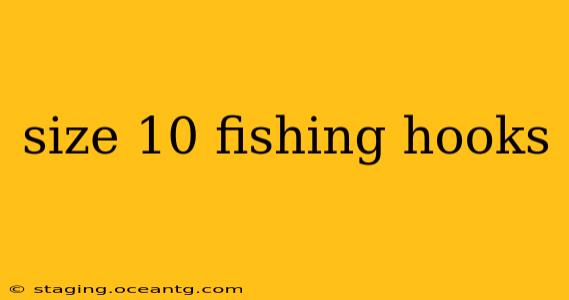Fishing hooks come in a bewildering array of sizes, and understanding the nuances of each size is crucial for successful angling. This guide focuses specifically on size 10 fishing hooks, exploring their ideal applications, suitable bait types, and the fish species they're best suited for. We'll also delve into common questions anglers have about this particular hook size.
What are Size 10 Fishing Hooks Used For?
Size 10 fishing hooks represent a medium-sized hook, versatile enough for a range of fishing scenarios. They aren't as tiny as those used for catching panfish, nor are they as large as those needed for tackling larger game fish. Their versatility is their strength. They're frequently used for:
- Panfish (some species): While smaller hooks are often preferred, a size 10 can work effectively for larger specimens of panfish like bluegill or crappie, especially when using larger live bait.
- Trout: Size 10 hooks are a popular choice for trout fishing, especially when using lures or smaller live bait. The hook size allows for a good balance between hook-up rate and minimizing damage to the fish.
- Bass (smaller): For smaller bass or young-of-the-year bass, a size 10 hook can be a suitable choice, especially when using finesse techniques or smaller artificial lures.
- Catfish (smaller): Smaller catfish, particularly those found in ponds or smaller rivers, can be successfully caught with a size 10 hook, particularly when using stink bait or worms.
What Kind of Bait Works Best with Size 10 Hooks?
The versatility of size 10 hooks extends to the types of bait they can effectively handle:
- Live Bait: Worms, minnows, and small crickets all work well on a size 10 hook. The hook size is large enough to securely hold the bait without being overly cumbersome.
- Artificial Lures: Smaller spinnerbaits, jigs, and crankbaits often utilize size 10 hooks, offering a good balance between hook size and lure action.
- Soft Plastics: Smaller soft plastic lures, like finesse worms or small grubs, can be effectively rigged on a size 10 hook, providing a natural presentation.
What Fish Can I Catch with a Size 10 Hook?
As mentioned earlier, size 10 hooks cater to a variety of fish species, depending on the fishing technique and location:
- Trout (various species): Brook trout, rainbow trout, and brown trout can all be successfully caught with a size 10 hook.
- Panfish (bluegill, crappie, etc.): Larger specimens of these species are suitable targets for size 10 hooks.
- Smallmouth Bass (younger or smaller): Smaller bass can be caught, but larger ones might bend or break the hook.
- Catfish (smaller): Channel catfish and bullheads of smaller sizes can be targeted with this hook size.
What is the Difference Between Size 10 and Other Hook Sizes?
Hook sizes are designated numerically, with smaller numbers representing larger hooks, and larger numbers representing smaller hooks. A size 10 hook is significantly smaller than a size 2 or 4 hook (typically used for much larger fish), but larger than a size 12 or 14 hook (often used for smaller panfish). The difference in size directly impacts the size of the fish you can target and the type of bait you can use.
Are Size 10 Hooks Good for Beginners?
Size 10 hooks provide a good middle ground for beginner anglers. They're not so small that they are difficult to handle, nor are they so large that they require excessive force to set the hook. Their versatility makes them a great starting point for exploring various fishing techniques and bait types.
What Type of Fishing Line Should I Use with Size 10 Hooks?
The appropriate line weight depends on the target species and fishing conditions. Generally, 4-6 lb test line is a suitable choice for panfish and smaller trout, while 8-10 lb test line might be better suited for larger trout or smaller bass.
This guide provides a comprehensive overview of size 10 fishing hooks. Remember to always choose the appropriate hook size for the fish you're targeting and the bait you're using. Happy fishing!
